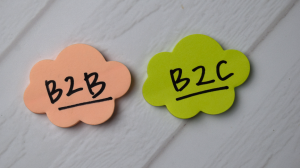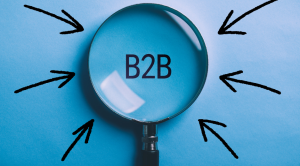We often come across terms like B2B and B2C in business. But what do they exactly mean? How are these models different from each other? This blog post will discuss everything you need to know about B2B and B2C business models. We will explore the main differences between the two models and their advantages. We will also look into how to price products for both models and provide some tips for setting up a successful B2B or B2C model. Whether you’re an entrepreneur starting a new venture or someone who wants to understand the basics of business models, this post is for you. Let’s dive in!
Understanding B2B and B2C Business Models

B2B and B2C business models are the two most common types of business models. Each has its own unique set of characteristics, which can be used to identify opportunities and optimize performance.
B2B businesses typically involve the sale of products or services to other businesses rather than to individual consumers. B2B companies often have longer sales cycles and higher average order values than B2C companies. They also tend to be more relationship-driven, with a focus on repeat customers and team building long-term relationships.
B2C businesses, on the other hand, sell directly to consumers. These companies generally have shorter sales cycles and lower average order values than B2B companies. They are also more transaction-oriented, with a focus on acquiring new customers.
Understanding the key differences between these two business models is essential for any company looking to optimize its performance. By understanding the unique needs of each type of customer, businesses can develop marketing strategies for targeting and servicing them effectively.
What are the Main Differences between B2B and B2C?

The main differences between B2B (business-to-business) and B2C (business-to-consumer) are as follows:
- Target Audience: B2B companies primarily target other businesses and organizations as their customers. B2C companies, on the other hand, target individual consumers as their customers.
- Decision-Making Process: In B2B transactions, the decision-making process is typically longer and involves multiple stakeholders. Decisions are often based on rational criteria such as cost, ROI, and specific business needs. In B2C transactions, the decision-making process is usually shorter and driven by emotional factors such as personal preferences, desires, and affordability.
- Relationship Focus: B2B relationships tend to be more focused on building long-term partnerships and fostering ongoing business relationships. B2C interactions, while still important, are often more transactional in nature, with less emphasis on long-term relationships.
- Sales Volume: B2B transactions generally involve larger order sizes, higher sales volumes, and fewer individual transactions compared to B2C. B2C transactions are typically characterized by smaller order sizes but a larger number of individual transactions.
- Marketing Strategies: B2B marketing often involves targeted campaigns aimed at specific industries, utilizing channels such as trade shows, industry publications, and professional networking events. B2C marketing, on the other hand, often employs mass marketing techniques, including TV ads, online advertising, social media, and other channels to reach a broader consumer base.
- Complexity of Products/Services: B2B offerings are usually more complex and specialized, often involving technical specifications and customized solutions tailored to meet specific business needs. B2C products and services are generally simpler and cater to the broader consumer market.
- Pricing and Negotiations: B2B business models and pricing structures are often more complex and customized, involving negotiation and tailored pricing agreements based on factors like volume, long-term contracts, and value-added services. B2C pricing is typically standardized and presented directly to consumers without negotiation.
- Customer Support: B2B customers often require more extensive customer support due to the complexity of the products or services. This can involve technical assistance, training, and ongoing account management. B2C customer support tends to focus on quick response times, addressing individual customer inquiries, and handling returns or exchanges.
Advantages of a B2B Model

There are many advantages of a B2B model, including:
- Increased Efficiency: A B2B model can help increase efficiency by automating processes and eliminating manual tasks. This can lead to faster turnaround times and improved accuracy.
- Improved Customer Service: A B2B model can help improve customer service by automating processes. This can lead to happier customers and improved retention rates.
- Cost Savings: A B2B model can help save money by reducing the need for paper documents and eliminating errors. This can lead to reduced costs for businesses.
- Increased Sales: A B2B model can help increase sales by allowing businesses to connect with more potential customers. This can lead to increased revenue for businesses.
Advantages of a B2C Model

There are several advantages of a business-to-consumer (B2C) model:
- Increased reach: A B2C model allows businesses to reach a larger audience than they would with a business-to-business (B2B) model. This is because consumers are more likely to search for and purchase products online than businesses are.
- Greater convenience: A B2C model offers greater convenience for businesses and consumers. For businesses, it eliminates the need to build and maintain relationships with other businesses. For consumers, it allows them to purchase products and services without having to leave their homes or offices.
- Lower prices: A B2C model typically results in lower prices for consumers. This is because businesses can sell directly to consumers without having to go through the middleman (i.e., wholesalers, retailers, etc.).
- Faster transactions: A B2C model generally results in faster transactions than a B2B model. This is because the transaction involves fewer steps (i.e., no need to negotiate prices, terms, etc.).
How to Price Products for B2B and B2C Business Models?

When it comes to pricing products, there are two main types of business models: B2B and B2C. Each type has its unique set of considerations that must be considered to come up with a pricing strategy that works.
B2B businesses typically have higher prices than B2C businesses selling that they are so selling that other businesses when afford to pay more. There are also usually fewer buyers in the market, so each one is worth more to the seller. The key considerations for B2B businesses when pricing their products are the costs of production, the competition, and the value to the buyer.
B2C businesses, on the other hand, typically have lower prices because they are selling to consumers who have less money to spend. There are also usually more buyers in the market, so each one is worth less to the seller. The key considerations for B2C businesses when pricing their products are the costs of production, the competition, and what consumers are willing to pay.
Tips for Setting Up a B2B or a B2C Model

There are a few key things to keep in mind when setting up a B2B or B2C model:
- Define your audience: Who are you selling to? What needs do they have that your product or service can address?
- Research your competition: What are they doing well? What could they improve upon? How can you position yourself as the best option for your target audience?
- Create a marketing and sales strategy: How will you reach your target market? What kind of messaging will resonate with them? How will you generate leads and conversions?
- Develop a pricing strategy: How much should you charge for your product or service? What kind of discounts or promotions can you offer to drive sales?
- Build out your infrastructure: What kind of website or eCommerce platform will you need? How will you fulfil orders and ship products? Who will handle customer service inquiries?
Following these tips, you can set up a successful B2B or B2C model to help you reach your business goals.
Conclusion
In conclusion, B2B and B2C models are fundamentally different models that cater to different audiences, with unique approaches to marketing and selling products or services. When it comes to deciding between the two, you must choose what aligns better with your business goals and target audience. A B2B model could offer higher revenue streams and more significant order sizes, but a B2C model targets a broader audience base with higher volume sales. It’s all about identifying which model will best serve your business goals. To learn more about setting up these models for your business, check out our blog post on tips for setting up a B2B or a B2C model.









